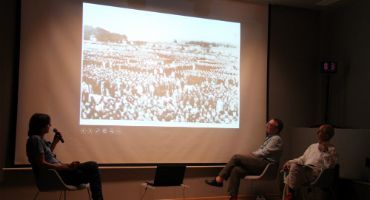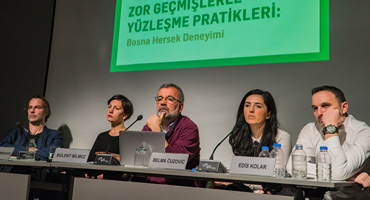The panel consisted of four speakers: Barbara Kirshenblatt Gimblett, the Chief Curator of the Core Exhibition at the POLIN Museum in Warsaw, Poland, Tristan Kobler, one of the two founders of Holzer Kobler Architekturen, an architecture firm in Zurich, Switzerland specializing in designing museums and exhibitions around the World; Mandy Sanger, the Education Program Coordinator of the District Six Museum in Cape Town, South Africa, and Lebogang Marishane, the Strategic Assistant at the Constitution Hill in Johannesburg, South Africa. The panel consisted of two sessions with the first session focusing on the practices from Europe and moderated by Cemal Kafadar.
Practices from Europe
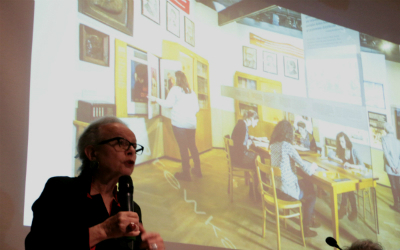
In her presentation entitled ‘Curating Between Hope and Despair’, Barbara Kirshenblatt Gimblett gave a talk about the history of the establishment of the POLIN Museum of the History of Polish Jews. This lecture explored the creation of the POLIN Museum and its multimedia narrative exhibition, ‘A Journey of a Thousand Years’, and its potential to be an agent of transformation that can move an entire society forward. Mrs. Kirshenblatt Gimblett draw attention to the fact that the museum is facing the Monument to the Ghetto Heroes on the site of the Warsaw Ghetto and the pre-World War II Jewish neighbourhood. The POLIN Museum of the History of Polish Jews completes the memorial complex. Mrs. Kirshenblatt Gimblett emphasized that at the monument, they honour those who died by remembering how they died. Whereas at the museum, they honour them and those who came before and after by remembering how they lived. According to Ms. Kirshenblatt Gimblett, as Poland was the centre of the Holocaust, telling the story where it happened was a matter of conscience. Kirshenblatt Gimblett also emphasized that it was of special importance to shed light on the 1,000+ years of history of Jewish people in Poland and design an exhibit between hope and despair.
Tristan Kobler, in his presentation entitled ‘Designing Sites of Reflection’ presented the museums and exhibitions that Holzer Kobler Architekturen has designed. Hozler Kobler Architekturen has been involved in designing inspiring exhibitions and museums. The new permanent exhibition, ‘Ostracism and Violence 1937 – 1945’ at the German National Buchenwald Memorial, the section entitled ‘On trial: Auschwitz/Majdanek’ and the exhibition ‘NO COMPROMISES! The Art of Boris Lurie’ at the Jewish Museum in Berlin, Germany, the Military History Museum in Dresden, Germany, and the Palaon Museum in Schoningen, Germany were among some of the works that were presented by Mr. Kobler during his presentation.
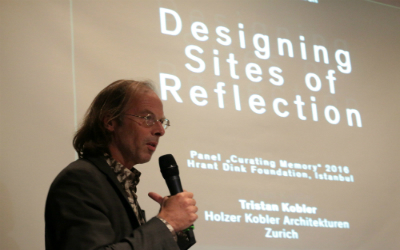
With a special focus on Buchenwald Concentration Camp’s new exhibition completely designed by Holzer Kobler Architekturen Mr. Kobler explained the designing process of Buchenwald’s new exhibition. Mr. Kobler mentioned that sometimes truth is much more complex than we think. In his presentation, Mr. Kobler explained that designing sites of reflection include creating spaces for memory, empathy, and for personal contemplation. Mr. Kobler highlighted the importance of creating space for reflection through creating voids in the exhibition space.He emphasized the importance of focusing on the objects in a minimalist way and presenting the personal stories of the objects.
Practices from South Africa
The second session focused on the practices from South Africa with Ayşe Gül Altınay moderating the panel. Lebogang Marishane, the Strategic Assistant at the Constitution Hill in Johannesburg, gave a presentation entitled ‘Using the Past to Build the New’. In her presentation, Mrs. Marishane focused on the South African story of transitional justice and the use of its painful past to build a new society. Mrs. Marishane explained in detail the creation of the Constitutional Court at the place which was formerly the prison complex and how the same bricks of the prison, which witnessed painful events in the past, were used to build the Constitution Court and, with it, the hope for a better future. In her presentation, Ms. Marishane explained the historical significance of the Constitution Hill. She explained that the four separate prisons on the site are over 100 years old and used to be places of horrific degradation and torture. Famous political prisoners, along with tens of thousands of ordinary black South Africans, whose only crime was disobeying one of the many discriminatory laws of the day, were all imprisoned there. Ms. Marishane mentioned that Constitution Hill is uniquely positioned as a place where both the difficulties of the past and the possibilities of the future can be experienced. Ms. Marishane also informed the participants about the ways to get young people engaged and interested and how they strive to use the space as creatively as possible to speak to various groups through the museum, exhibitions, educational programs, documentation, and a range of other activities.
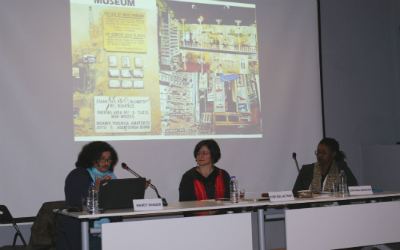
The final speaker of the second panel session, Mandy Sanger, the Education Program Coordinator of the District Six Museum in Cape Town gave a presentation entitled ‘The Pedagogy of Memorialization’. Ms. Sanger presented the history of the District Six Museum and the education programs that they implement. Ms. Sanger stated that the District Six Museum is a site of conscience in many ways and she explained that the District Six Museum questions the approaches to trauma. Ms. Sanger pointed out that history & memory work is not neutral and is not always a benign practice and she revealed that the work of the museum reconstructs memory from fragments and as a place of doing activities and reconstructs the past as a participatory process. The presentation enabled the participants to explore the importance of memorialization and how various forms of engagement are important for keeping the memory or memories alive. Ms. Sanger emphasized that the District Six Museum gives special importance to intergenerational and multi-disciplinary oral history, storytelling, and place-making projects.



